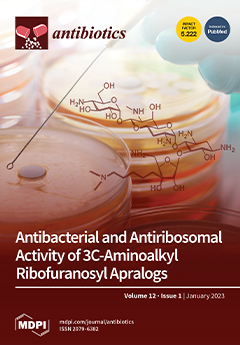The purpose of the study was to describe the antimicrobial activity of 16 common essential oils (EOs) on multidrug-resistant (MDR)
Pseudomonas aeruginosa clinical isolates, including the determination of the effects on
mex efflux pumps gene expression. Seventy-two clinical isolates of
P. aeruginosa collected
[...] Read more.
The purpose of the study was to describe the antimicrobial activity of 16 common essential oils (EOs) on multidrug-resistant (MDR)
Pseudomonas aeruginosa clinical isolates, including the determination of the effects on
mex efflux pumps gene expression. Seventy-two clinical isolates of
P. aeruginosa collected between 2020–2022 were screened for susceptibility to EOs using Kirby–Bauer disk diffusion to identify potential candidates for future alternative therapies. The minimal inhibitory concentration (MIC) was further determined for the EO that proved antibacterial activity following the disk diffusion screening. Positive and negative controls were also used for method validation. Since cinnamon EO exhibited the best antimicrobial activity, it was further used to evaluate its influence on
mex A, B, C, E, and X efflux pumps gene expression using real-time RT-PCR. Cinnamon EO inhibited all
P. aeruginosa strains, followed by thyme EO (37.5%,
n = 27) and lavender EO (12.5%,
n = 9). The other EOs were less efficient. The MIC detection showed that cinnamon at a concentration of 0.05%
v/
v inhibited all MDR
P. aeruginosa isolates. Thyme, turmeric, peppermint, basil, clove, and lavender EOs presented various results, most of them having activity at concentrations higher than 12.5%
v/
v. By studying the activity of cinnamon EO on
mex efflux pumps, it was found that
mexA and
mexB (66.5%) were generally under-expressed. The remarkable results produced using the very low concentrations of cinnamon EO, with 100% antimicrobial activity against multi-, extended-, and pan- drug-resistant (MDR, XDR, PDR)
P. aeruginosa clinical isolates, completed with the severe alteration of the RNA messaging system, supports its potential to be used as adjuvant treatment, with impact on therapeutic results.
Full article






